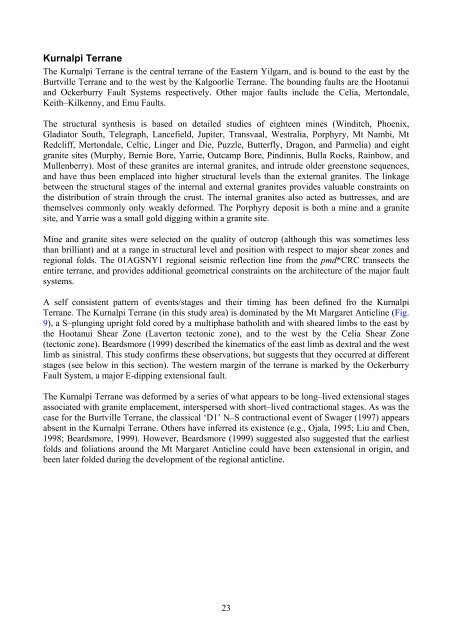Tectonostratigraphic architecture and uplift history of the Eastern ...
Tectonostratigraphic architecture and uplift history of the Eastern ...
Tectonostratigraphic architecture and uplift history of the Eastern ...
Create successful ePaper yourself
Turn your PDF publications into a flip-book with our unique Google optimized e-Paper software.
Kurnalpi TerraneThe Kurnalpi Terrane is <strong>the</strong> central terrane <strong>of</strong> <strong>the</strong> <strong>Eastern</strong> Yilgarn, <strong>and</strong> is bound to <strong>the</strong> east by <strong>the</strong>Burtville Terrane <strong>and</strong> to <strong>the</strong> west by <strong>the</strong> Kalgoorlie Terrane. The bounding faults are <strong>the</strong> Hootanui<strong>and</strong> Ockerburry Fault Systems respectively. O<strong>the</strong>r major faults include <strong>the</strong> Celia, Mertondale,Keith–Kilkenny, <strong>and</strong> Emu Faults.The structural syn<strong>the</strong>sis is based on detailed studies <strong>of</strong> eighteen mines (Winditch, Phoenix,Gladiator South, Telegraph, Lancefield, Jupiter, Transvaal, Westralia, Porphyry, Mt Nambi, MtRedcliff, Mertondale, Celtic, Linger <strong>and</strong> Die, Puzzle, Butterfly, Dragon, <strong>and</strong> Parmelia) <strong>and</strong> eightgranite sites (Murphy, Bernie Bore, Yarrie, Outcamp Bore, Pindinnis, Bulla Rocks, Rainbow, <strong>and</strong>Mullenberry). Most <strong>of</strong> <strong>the</strong>se granites are internal granites, <strong>and</strong> intrude older greenstone sequences,<strong>and</strong> have thus been emplaced into higher structural levels than <strong>the</strong> external granites. The linkagebetween <strong>the</strong> structural stages <strong>of</strong> <strong>the</strong> internal <strong>and</strong> external granites provides valuable constraints on<strong>the</strong> distribution <strong>of</strong> strain through <strong>the</strong> crust. The internal granites also acted as buttresses, <strong>and</strong> are<strong>the</strong>mselves commonly only weakly deformed. The Porphyry deposit is both a mine <strong>and</strong> a granitesite, <strong>and</strong> Yarrie was a small gold digging within a granite site.Mine <strong>and</strong> granite sites were selected on <strong>the</strong> quality <strong>of</strong> outcrop (although this was sometimes lessthan brilliant) <strong>and</strong> at a range in structural level <strong>and</strong> position with respect to major shear zones <strong>and</strong>regional folds. The 01AGSNY1 regional seismic reflection line from <strong>the</strong> pmd*CRC transects <strong>the</strong>entire terrane, <strong>and</strong> provides additional geometrical constraints on <strong>the</strong> <strong>architecture</strong> <strong>of</strong> <strong>the</strong> major faultsystems.A self consistent pattern <strong>of</strong> events/stages <strong>and</strong> <strong>the</strong>ir timing has been defined fro <strong>the</strong> KurnalpiTerrane. The Kurnalpi Terrane (in this study area) is dominated by <strong>the</strong> Mt Margaret Anticline (Fig.9), a S–plunging upright fold cored by a multiphase batholith <strong>and</strong> with sheared limbs to <strong>the</strong> east by<strong>the</strong> Hootanui Shear Zone (Laverton tectonic zone), <strong>and</strong> to <strong>the</strong> west by <strong>the</strong> Celia Shear Zone(tectonic zone). Beardsmore (1999) described <strong>the</strong> kinematics <strong>of</strong> <strong>the</strong> east limb as dextral <strong>and</strong> <strong>the</strong> westlimb as sinistral. This study confirms <strong>the</strong>se observations, but suggests that <strong>the</strong>y occurred at differentstages (see below in this section). The western margin <strong>of</strong> <strong>the</strong> terrane is marked by <strong>the</strong> OckerburryFault System, a major E-dipping extensional fault.The Kurnalpi Terrane was deformed by a series <strong>of</strong> what appears to be long–lived extensional stagesassociated with granite emplacement, interspersed with short–lived contractional stages. As was <strong>the</strong>case for <strong>the</strong> Burtville Terrane, <strong>the</strong> classical ‘D1’ N–S contractional event <strong>of</strong> Swager (1997) appearsabsent in <strong>the</strong> Kurnalpi Terrane. O<strong>the</strong>rs have inferred its existence (e.g., Ojala, 1995; Liu <strong>and</strong> Chen,1998; Beardsmore, 1999). However, Beardsmore (1999) suggested also suggested that <strong>the</strong> earliestfolds <strong>and</strong> foliations around <strong>the</strong> Mt Margaret Anticline could have been extensional in origin, <strong>and</strong>been later folded during <strong>the</strong> development <strong>of</strong> <strong>the</strong> regional anticline.23

















